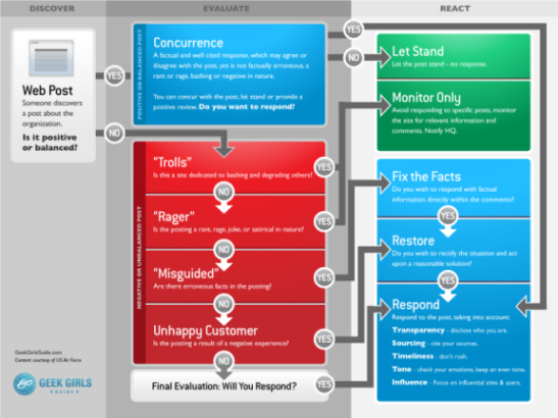Guest post by Nancy Lyons and Meghan Wilker of the Geek Girls Guide.
 The above flowchart (full-size image here) is an edited version of an official document authored and circulated by the Air Force – the “United States Air Force’s Web Response Assessment.” We use this document often (with permission) and believe it to be an ideal example of a social media response plan.
The above flowchart (full-size image here) is an edited version of an official document authored and circulated by the Air Force – the “United States Air Force’s Web Response Assessment.” We use this document often (with permission) and believe it to be an ideal example of a social media response plan.
We love it so much we share it with brands and businesses of all types looking for a solid foundation from which to build their own plan. The whole thing is pretty darn valuable, but we couldn’t help but call out some critical points.
Here are five things the Air Force knows about social media that you should, too:
1. Don’t feed the trolls.
A troll is someone who posts intentionally inflammatory comments, and “Don’t feed the trolls” is an adage that dates back to the early days of the Internet.
Trolls are everywhere and there’s nothing you can do about them, except ignore them. The best way to learn this lesson is, as in many things, the hard way. A troll will comment on your blog, and you’ll attempt to engage them in a real discussion, which will lead to stress and frustration. It’s like arguing with a toddler. There are no winners.
So, the best approach – as the Air Force outlines – is to let sleeping trolls lie.
2. Think before you respond.
This rule, of course, applies to all kinds of communication – not just social media. Healthy, productive communication requires that we are thoughtful.
The beauty of the Air Force assessment is that it institutionalizes the thoughtfulness. If everyone who responds takes part in the same thought process around if – and how – to respond, the likelihood that the response will align with the organization’s values is much higher.
Sometimes the best response is no response at all. And sometimes waiting allows others to respond on your behalf, which is much more powerful.
3. Listen, but don’t respond, to everything.
This chart provides great bones for how to respond to conversations that are taking place online about your organization. What needs to be layered on top of this is the personality and brand promise of your organization. Your job is to decide what is appropriate for your brand, your industry, and the communities you serve.
If there is one thing missing from this chart, it’s an escalation plan. Does your organization need a process for escalating a quick response to a post that may have legal implications? Do you need a separate crisis response plan? These are critical questions to answer when determining how to respond to more sensitive conversations.
4. Give responders clear guidelines.
If you choose to respond, the guidelines outlined here are crucial:
- Transparency: Be transparent in revealing who you are and your role in the discussion.
- Sourcing: Have and openly cite sources that support your response.
- Timeliness: Don’t rush into a response, but remember that critical conversations require sensitivity to response time.
- Tone: (We added this one to the Air Force original version.) Remember the Internet is a place where messaging can be misinterpreted. Less is more, be specific, and keep personal emotions in check.
- Influence: This is not about looking at numbers of followers, but at what influence a person may have on the conversation you are participating in.
5. Find a common language.
A social media response plan is an agreement that you are making internally among employees, and externally with your audiences. Making this information public means that employees have a clear understanding about how to respond appropriately, and external audiences clearly understand how you may (or may not) engage with them online.
Click on these links for examples of public social media policies or the original Air Force Response Plan.
Nancy Lyons is president and CEO of Clockwork Active Media Systems; Meghan Wilker is managing director. In 2008, they launched the Geek Girls Guide as a place to publish their perspective on the Interactive industry and demystify technology for non-technical audiences.
